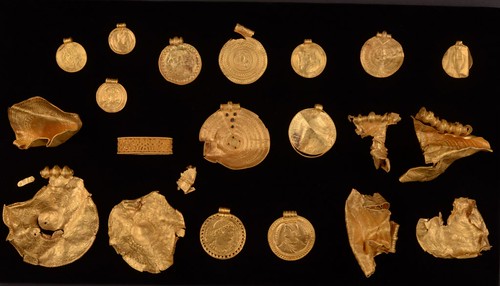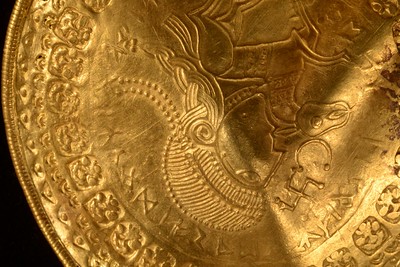
PREV ARTICLE
NEXT ARTICLE
FULL ISSUE
PREV FULL ISSUE
DENMARK GOLD FIND EXHIBITEDRobert Hoge passed along this story of a great Iron Age gold find. Thanks. -Editor Ole Ginnerup Schytz’s first time using a metal detector proved a rewarding one last December when the rookie treasure hunter found a stunning cache of 6th century gold jewelry in a field near the town of Jelling in Denmark.
When the device’s sensors activated, Schytz started digging, unearthing a small piece of twisted metal. The reality was far more exciting: In an astounding bit of beginner’s luck, Schytz had stumbled across no fewer than 22 pieces of gold treasure from the Iron Age, weighing just over two pounds in total. It had been buried for some 1,500 years. Now, eight months later, the stunning find, which predates the Viking era, has been revealed in all its glittering glory by the Vejlemuseerne in southern Jutland.
The bulk of the treasure are bracteates, a kind of flat thin medallion with engravings on one side that was common in northern Europe during the Migration Period (375–568). The jewelry is decorated with runes, magical symbols, and religious imagery such as the Norse god Odin, all reflecting delicate craftsmanship of the highest order. Women would have worn the amulets for protection. Other gold pieces are coins from the Roman Empire, including one from the reign of Constantine the Great, who was in power from 285–337, hundreds of years before the gold was buried in a village longhouse. That suggests a robust trade network across the European continent, while the treasure’s enormous wealth suggests the area around Jelling was a seat of power. Experts believe the gold was hidden around the time of a large volcanic eruption in the year 536, which triggered widespread famine in Scandinavia.
To read the complete article, see:
To read another article with more images, see:
Wayne Homren, Editor The Numismatic Bibliomania Society is a non-profit organization promoting numismatic literature. See our web site at coinbooks.org. To submit items for publication in The E-Sylum, write to the Editor at this address: whomren@gmail.com To subscribe go to: https://my.binhost.com/lists/listinfo/esylum All Rights Reserved. NBS Home Page Contact the NBS webmaster 
|


